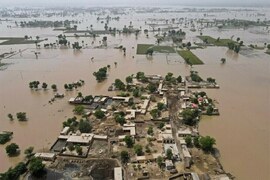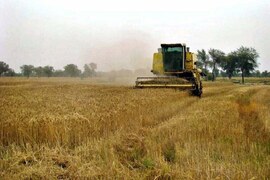Europe's wheat crop has enjoyed good growing conditions so far and with another large harvest on the cards, rising stockpiles of grain could pose an even bigger headache next year, analysts said on Tuesday. Parts of Spain are lacking rain and snow has covered fields in Hungary, Russia and Ukraine, but the EU remains on track to raise wheat production from last year due to a bigger sown area. "We've seen snow in the east but that has provided enough protection against the low temperatures. I don't think we'll see much in the way of winter kill," analyst James Dunsterville of AgriNews in Geneva said.
"It has been dry in Spain and Portugal, but I don't think alarm bells are ringing there just yet."
In France, Europe's biggest producer, the area sown to wheat is up 3.3 percent on 2004, grain office ONIC has estimated.
The farm ministry forecast is slightly lower but still sees the area four percent above the five-year average. It said there had been no sign of the damaging frosts of two years ago.
"The sowing and initial plant growth for arable crops have occurred in satisfactory conditions overall, in particular concerning temperatures," its latest crop report said.
However, the environment ministry has raised potential problems with rainfall, saying low levels in January across the country had exacerbated a dry spell that has lasted for months.
"We need above average rainfall in the coming months to turn this situation around," its latest report said.
In Spain, farmers are worried about a lack of rain but say it is too early to judge the final impact on the crop.
Andalusia, where most of the grain crop is durum wheat, has been worst-hit. Ramon Garcia, technician at farmers' union COAG, said in the province of Seville, 70 percent of the crop had been damaged and in Cadiz it was even worse.
"Every day that passes the situation gets worse," he said.
In Castille-Leon, home to a third of Spain's grain crop, there has been little rain but the situation is reversible.
"(In the north) the drought isn't so drastic there is still water but it all depends on the Spring ... if it still isn't raining by the spring that could spoil it," COAG's Pablo Resco, a Madrid-based technician, said.
German grain plantings are progressing well in average winter conditions with no major concerns about frost damage to crops, a German analyst said.
"Where deep frosts have occurred in east and south Germany they were in areas where there was good snow cover and the frosts were not serious enough to penetrate this," he said.
In January, Germany's government estimated German winter wheat plantings for harvesting this year had risen 2.2 percent to 3,122,000 hectares, increasing expectations of a large crop.
The latest EU data shows wheat intervention stocks at 4.43 million tonnes and rising.
Analysts expect stocks to rise by at least another couple of million tonnes this season, despite the European Commission's recent decision to revive export refunds, which help country's such as France but do little for those in east such as Hungary.
This would leave millions of tonnes in store at the start of next season in July, building up problems for later this year.
"If we go though winter and spring with few weather problems, and the world market remains well supplied, then the Commission is looking at another season with prices drifting at the intervention levels," Dunsterville said.
"If the Commission doesn't significantly alter the way grain is exported out of the bloc, land-locked countries like Hungary will continue to have a mountain of grain," he added.
BR100
15,235
Increased By
150.4 (1%)
BR30
44,824
Increased By
812 (1.85%)
KSE100
149,971
Increased By
1353.3 (0.91%)
KSE30
45,655
Increased By
407.2 (0.9%)






















Comments
Comments are closed.